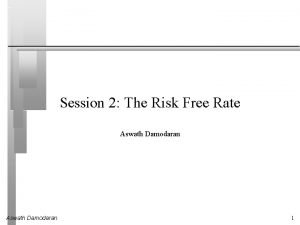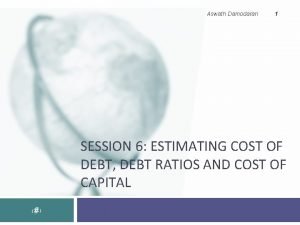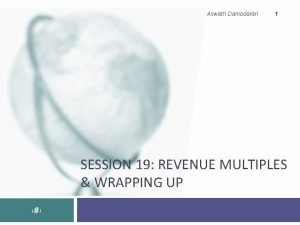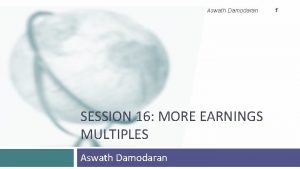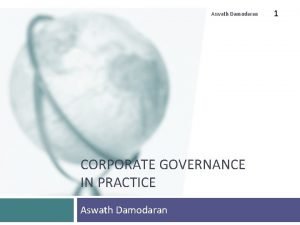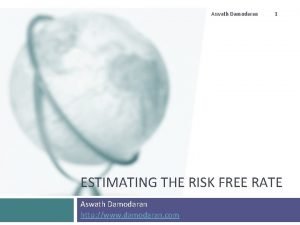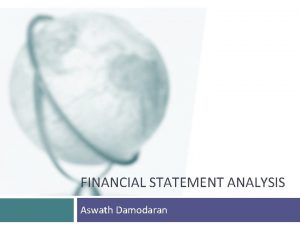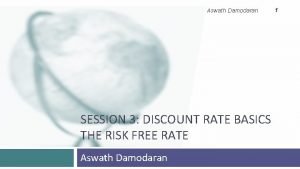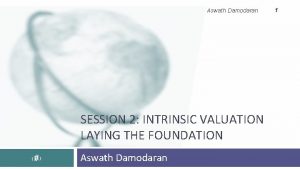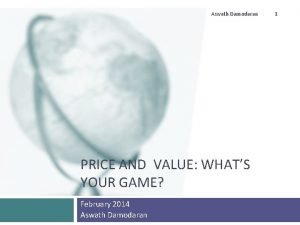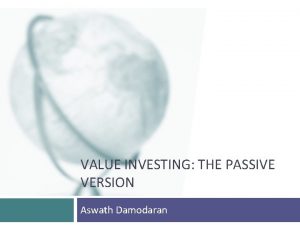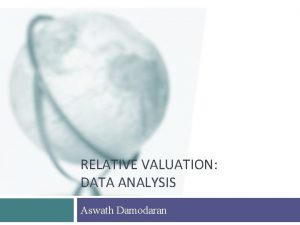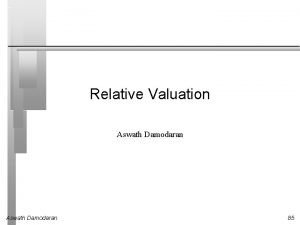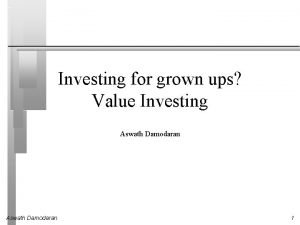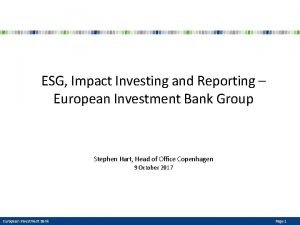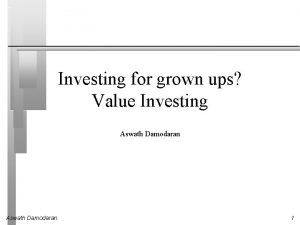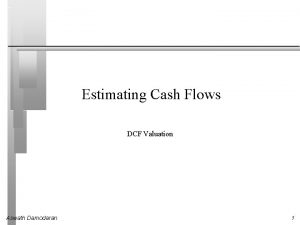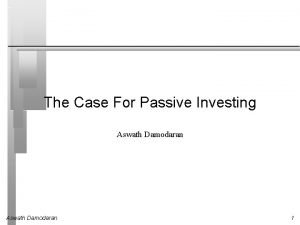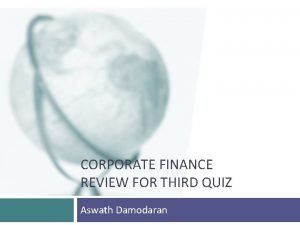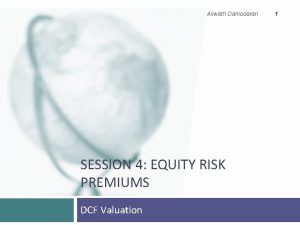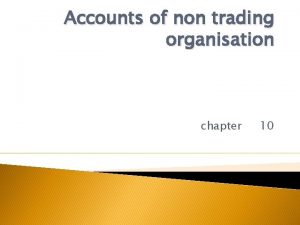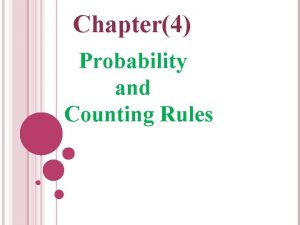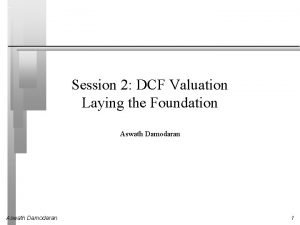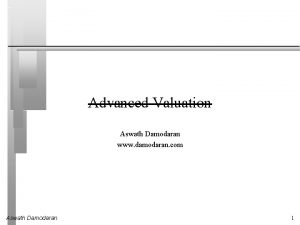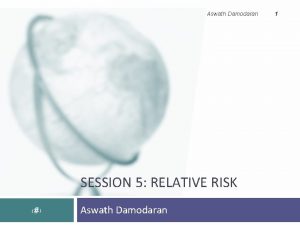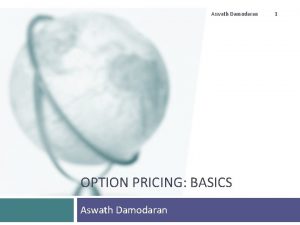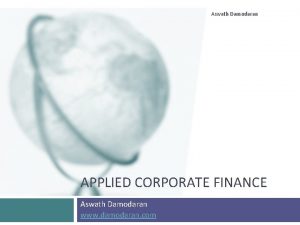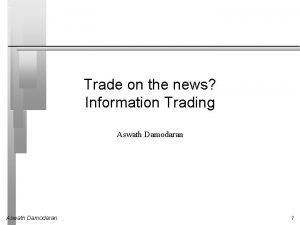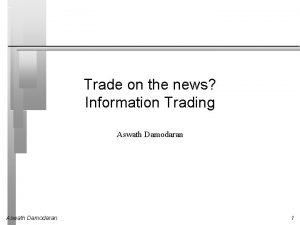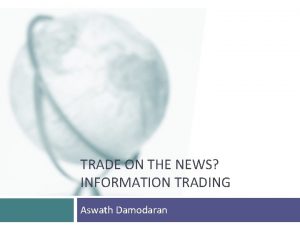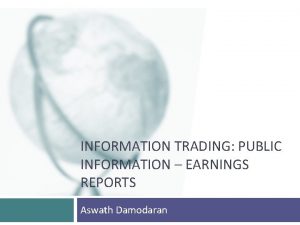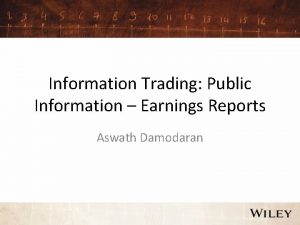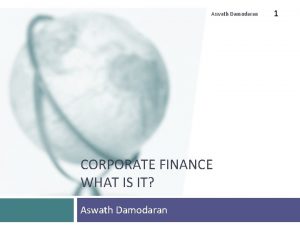Trade on the news Information Trading Aswath Damodaran
















































- Slides: 48

Trade on the news? Information Trading Aswath Damodaran

Information and Value • Investors attempt to assess the value of an asset based upon the information that they have about that asset at that point in time. • At the same time, different investors will arrive at different assessments of value for the same asset – Because the information they have is different – Because they have different ways of processing the same information • The price is determined by demand supply.

Information and Prices in an Efficient Market

A Slow Learning Market…

An Overreacting Market

Trading on Private Information • Insiders are managers, directors or major stockholders in firms. While they are constrained from trading ahead of information releases, they can still legally buy or sell stock in their companies. • Analysts operate at the nexus of private and public information. To the extent that they “know” something about the company that the rest of us do not, their recommendations should convey information to the market. • One way to examine whether private information can be used to earn excess returns is to look at whether insiders and analysts earn excess returns.

Insider Trading as a Leading Indicator of Stock prices. .

More on insider trading… • Studies since support this finding, but it is worth noting that insider buying is a noisy signal – about 4 in 10 stocks where insiders are buying turn out to be poor investments, and even on average, the excess returns earned are not very large. • In a study in 1998, Lakonishok and Lee take a closer look at the price movements around insider trading. They find that firms with substantial insider selling have stock returns of 14. 4% over the subsequent 12 months, which is significantly lower than the 22. 2% earned by firms with insider buying. • However, they find that the link between insider trading and subsequent returns is greatest for small companies and that there is almost no relationship at larger firms.

Insider trading - updated • The first is that the SEC has become more expansive in its definition of what constitutes insider information (to include any material non -public information, rather than just information releases from the firm) and more aggressive in its enforcement of insider trading laws. • The second is that companies, perhaps in response to the SEC’s hard line on insider trading, have adopted more stringent policies restricting insiders from trading on information. Perhaps as a consequence, the price effect of insider trading has decreased over time and one study finds that the price effect of (legal) insider trading has almost disappeared since 2002, with the adoption of Regulation Fair Disclosure (FD), which restricted selective information disclosure by companies to a few investors or analysts, and Sarbanes-Oxley, which increased scrutiny of insider trading.

Can you follow insiders and make money?

Are some insiders more inside than others? • Not all insiders have equal access to information. Top managers and members of the board should be privy to much more important information and thus their trades should be more revealing. A study by Bettis, Vickrey and Vickery finds that investors who focus only on large trades made by top executives, rather than total insider trading may, in fact, be able to earn excess returns. • As investment alternatives to trading on common stock have multiplied, insiders have also become more sophisticated about using these alternatives. As an outside investor, you may be able to add more value by tracking these alternative investments. • Knowledge about insider trading is more useful in some companies than in others. Insider buying or selling is likely to contain less information (and thus be less useful to investors) in companies where information is plentiful (both because of disclosure by the company and analysts following the company) and easy to assess.

Illegal Insider Trading: Is it profitable? • When insiders are caught trading illegally, they almost invariably have made a killing on their investment. Clearly, some insiders made significant returns off their privileged positions. • Almost all major news announcements made by firms are preceded by a price run-up (if it is good news) or a price drop (if it is bad news). While this may indicate a very prescient market, it is much more likely that someone with access to the privileged information (either at the firm or the intermediaries helping the firm) is using the information to trade ahead of the news. In fact, the other indicator of insider trading is the surge in trading volume in both the stock itself and derivatives prior to big news announcements. • In addition to having access to information, insiders are often in a position to time the release of relevant information to financial markets. One study find that insiders sell stock between 3 and 9 quarters before their firms report a break in consecutive earnings increases. They also find, for instance, that insider selling increases at growth firms prior to periods of declining earnings.

Analysts • Analysts have access to public information and to the managers of the firm (and thus to private information). • Analysts make earnings forecasts for firms (and revise them) and recommendations on buy and sell.

Who do analysts follow?

Determinants of analyst following… • Market Capitalization: The larger the market capitalization of a firm, the more likely it is to be followed by analysts. • Institutional Holding: The greater the percent of a firm’s stock that is held by institutions, the more likely it is to be followed by analysts. The open question, though, is whether analysts follow institutions or whether institutions follow analysts. Given that institutional investors are the biggest clients of equity research analysts, the causality probably runs both ways. • Trading Volume: Analysts are more likely to follow liquid stocks. Here again, though, it is worth noting that the presence of analysts and buy (or sell) recommendations on a stock may play a role in increasing trading volume.

I. Earnings Forecasts • Analysts spend a considerable amount of time estimating the earnings per share that companies will report in the next quarter. They also provide forecasts of earnings further out - up to 5 years. • Analysts also constantly update these forecasts as new information comes out. To the extent that there is information in these revisions, stock prices should react.

Information in Earnings Forecasts • • • Firm-specific information that has been made public since the last earnings report: Analysts can use information that has come out about the firm since the last earnings report, to make predictions about future growth. Macro-economic information that may impact future growth : Analysts can update their projections of future growth as new information comes out about the overall economy and about changes in fiscal and monetary policy. Information revealed by competitors on future prospects: Analysts can also condition their growth estimates for a firm on information revealed by competitors on pricing policy and future growth. Private information about the firm: Analysts sometimes have access to private information about the firms they follow which may be relevant in forecasting future growth. Public information other than earnings: It has been shown, for instance, that other financial variables such as earnings retention, profit margins and asset turnover are useful in predicting future growth. Analysts can incorporate information from these variables into their forecasts.

The Quality of Earnings Forecasts • The general consensus from studies that have looked at short-term forecasts (one quarter ahead to four quarters ahead) of earnings is that analysts provide better forecasts of earnings than models that depend purely upon historical data. The mean relative absolute error, which measures the absolute difference between the actual earnings and the forecast for the next quarter, in percentage terms, is smaller for analyst forecasts than it is forecasts based upon historical data. • A study in 1978 measured the squared forecast errors by month of the year and computed the ratio of analyst forecast error to the forecast error from time-series models of earnings. It found that the time series models actually outperform analyst forecasts from April until August, but underperform them from September through January. • The other study by O'Brien (1988) found that analyst forecasts outperform the time series model for one-quarter ahead and two-quarter ahead forecasts, do as well as the time series model for three-quarter ahead forecasts and do worse than the time series model for four-quarter ahead forecasts.

Analyst Errors seem to be related to macroeconomic conditions…

How about long term forecasts? • There is little evidence to suggest that analysts provide superior forecasts of earnings when the forecasts are over three or five years. An early study by Cragg and Malkiel compared long-term forecasts by five investment management firms in 1962 and 1963 with actual growth over the following three years to conclude that analysts were poor long term forecasters. • This view was contested in 1988 by Vander Weide and Carleton who found that the consensus prediction of five-year growth in the I/B/E/S was superior to historically oriented growth measures in predicting future growth.

Market Reaction to Earnings Revisions… • In one of the earliest studies of this phenomenon, Givoly and Lakonishok created portfolios of 49 stocks in three sectors, based upon earnings revisions, and reported earning an excess return on 4. 7% over the following four months on the stocks with the most positive revisions. • Hawkins, in 1983, reported that a portfolio of stocks with the 20 largest upward revisions in earnings on the I/B/E/S database would have

Potential Pitfalls and possible use… • The limitation of an earnings momentum strategy is its dependence on two of the weakest links in financial markets –earnings reports that come from firms (where accounting games skew earnings)and analyst forecasts of these earnings (which are often biased). • To the extent that analysts influence trades made by their clients, they are likely to affect prices when they revise earnings. The more

II. Recommendations: Some background

Market Reaction…

Tempered by fears of bias…

Using Analyst Recommendations… • Can you make money off analyst recommendations? – Stock prices should go up on recommendations, even if there is no new information in them, because there is a self fulfilling prophecy. – If this is the only reason for the stock price reaction, though, the returns are not only likely to be small but could very quickly dissipate. • A four step process to getting the most out of analysts: – Identify the analysts who are not only the most

Trading on Public Information • There is substantial information that comes out about stocks. Some of the information comes from the firm - earnings and dividend announcements, acquisitions and other news and some comes from competitors. • Prices generally react to this information.

I. Earnings Announcements • Every quarter (in the U. S) and less frequently elsewhere, firms report their earnings for the most recent period. • When firms make earnings announcements, they convey information to financial markets about their current and future prospects. The magnitude of the information, and the size of the market reaction, should depend upon how much the earnings report exceeds or falls short of investor expectations.

Market Reaction to Earnings Reports

The post-announcement drift?

By day of the week. .

The Consequence of Delays…

The Intraday reaction. .

And earnings quality matters… • As firms play the earnings game, the quality of earnings has also diverged across companies. A firm that beats earnings estimates because it has more efficient operating should be viewed more favorably than one that beats estimates because it changed the way it valued inventory. • Chan, Jegadeesh and Lakonishok examined firms that reported high accruals – i. e. the difference between accounting

Can you make money of earnings announcements? • One strategy is to buy stocks that report large positive earnings surprises, hoping to benefit from the drift. The evidence indicates that across all stocks, the potential for excess returns from buying after earnings announcements is very small. • You can concentrate only on earnings announcements made by smaller, less liquid companies where the drift is more pronounced. In addition, you can try to direct

II. Acquisitions

Across different types of acquisitions…

The Effect on Acquirers. . • Jensen and Ruback report excess returns of 4% for bidding firm stockholders around tender offers and no excess returns around mergers. Jarrell, Brickley and Netter, in their examination of tender offers from 1962 to 1985, note a decline in excess returns to bidding firm stockholders from 4. 4% in the 1960 s to 2% in the 1970 s to -1% in the 1980 s. • Other studies indicate that approximately half of all bidding firms earn negative excess

After the acquisition… Operating Evidence • Mc. Kinsey and Co. examined 58 acquisition programs between 1972 and 1983 for evidence on two questions: (1) Did the return on the amount invested in the acquisitions exceed the cost of capital? (2) Did the acquisitions help the parent companies outperform the competition? They concluded that 28 of the 58 programs failed both tests, and six failed at least one test. • In a follow-up study of 115 mergers in the U. K.

After the acquisition… Divestitures • The most damaging piece of evidence on the outcome of acquisitions is the large number of acquisitions that are reversed within fairly short time periods. Mitchell and Lehn note that 20. 2% of the acquisitions made between 1982 and 1986 were divested by 1988. In a study published in 1992, Kaplan and Weisbach found that 44% of the mergers they studied were reversed, largely because the acquirer paid too much or because the operations of

Takeover based investment strategies • The first and most lucrative, if you can pull it off, is to find a way (legally) to invest in a target firm before the acquisition is announced. • The second is to wait until after the takeover is announced and then try to take advantage of the price drift between the announcement date and the day the deal is consummated. This is often called risk arbitrage. • The third is also a post-announcement

Preannouncement Trading • Research indicates that the typical target firm in a hostile takeover has the following characteristics: – It has under performed other stocks in its industry and the overall market, in terms of returns to its stockholders in the years preceding the takeover. – It has been less profitable than firms in its industry in the years preceding the takeover. – It has a much lower stock holding by insiders than do firms in its peer groups. – It has a low price to book ratio & a low ratio of

Post-Announcement Trading • In this strategy, you buy companies after acquisitions or mergers are completed because you believe that they will be able to deliver what they promise at the time of the merger – higher earnings growth and synergy. • The likelihood of success seems to be greater – In hostile acquisitions, where the management is replaced. – In mergers of like businesses than in conglomerate mergers

III. Stock Splits

IV. Dividend Changes

Have dividends become less informative?

Implementing an Information Based Strategy: Determinants of Success • Identify the information around which your strategy will be built: Since you have to trade on the announcement, it is critical that you determine in advance the information that will trigger a trade. • Invest in an information system that will deliver the information to you instantaneous: Many individual investors receive information with a time lag – 15 to 20 minutes after it reaches the trading floor and institutional

In closing. . • If you can trade on private information, you can get ahead of market movements. Unfortunately, trading on private information is usually illegal. • You can trade on information after it has been made public, taking advantage of systematic errors that markets make in how they react. If markets overreact, you will buy after bad news and sell after good news. If markets under react, you will buy after good news and
 Damodaran default spread
Damodaran default spread Www.damodaran
Www.damodaran Damodaran.com
Damodaran.com Aswath damodaran value investing
Aswath damodaran value investing Damodaran statistics
Damodaran statistics Default spread damodaran
Default spread damodaran Damodaran multiple
Damodaran multiple Pbv
Pbv Aswath damodaran discount rate
Aswath damodaran discount rate Ebitda multiples for trucking companies
Ebitda multiples for trucking companies Aswath damodaran age
Aswath damodaran age Aswath damodaran risk free rate
Aswath damodaran risk free rate Aswath damodaran website
Aswath damodaran website Contrarian value investing
Contrarian value investing Aswath damodaran accounting 101
Aswath damodaran accounting 101 Aswath damodaran
Aswath damodaran Aswath damodaran discount rate
Aswath damodaran discount rate Aswath damodaran intrinsic value
Aswath damodaran intrinsic value Aswath damodaran intrinsic value
Aswath damodaran intrinsic value Aswath damodaran value investing
Aswath damodaran value investing Aswath damodaran formação
Aswath damodaran formação Data damodaran
Data damodaran Damodaran relative valuation
Damodaran relative valuation Damodaran on valuation review
Damodaran on valuation review Aswath damodaran value investing
Aswath damodaran value investing Aswath damodaran discount rate
Aswath damodaran discount rate Aswath damodaran esg
Aswath damodaran esg Damodaran
Damodaran Non cash working capital dcf
Non cash working capital dcf Aswath damodaran
Aswath damodaran Aswath damodaran review
Aswath damodaran review Erp damodaran
Erp damodaran Aswath damodaran
Aswath damodaran Accounting for non trading organisation
Accounting for non trading organisation Hard news vs soft news
Hard news vs soft news Chapter 4 probability and counting rules
Chapter 4 probability and counting rules Both of the statues on the shelf is broken
Both of the statues on the shelf is broken Trade diversion and trade creation
Trade diversion and trade creation Trade diversion and trade creation
Trade diversion and trade creation Which is the most enduring free trade area in the world?
Which is the most enduring free trade area in the world? The trade in the trade-to-gdp ratio
The trade in the trade-to-gdp ratio Fair trade not free trade
Fair trade not free trade Trade diversion and trade creation
Trade diversion and trade creation Tramp trade software
Tramp trade software Ted talk atlantic slave trade
Ted talk atlantic slave trade Dcf aswath
Dcf aswath Hình ảnh bộ gõ cơ thể búng tay
Hình ảnh bộ gõ cơ thể búng tay Bổ thể
Bổ thể
